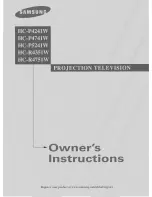
Connections
ENGLISH - 33
Getting Started
▶
■
<HDMI IN> terminal pin assignments and signal names
Outside view
Pin No.
Signal name
Pin No.
Signal name
(1)
T.M.D.S data 2+
(11)
T.M.D.S clock shield
(2)
T.M.D.S data 2 shield
(12)
T.M.D.S clock–
Even-numbered pins
(2)
to
(18)
(3)
T.M.D.S data 2–
(13)
CEC
(1)
(19)
(2)
(18)
(4)
T.M.D.S data 1+
(14)
—
(5)
T.M.D.S data 1 shield
(15)
SCL
(6)
T.M.D.S data 1–
(16)
SDA
(7)
T.M.D.S data 0+
(17)
DDC/CEC
GND
Odd-numbered pins
(1)
to
(19)
(8)
T.M.D.S data 0 shield
(18)
+5 V
(9)
T.M.D.S data 0–
(19)
Hot plug detection
(10)
T.M.D.S clock+
Connecting example: AV equipment
VCR (with built-in TBC)
DVD player with attached
HDMI terminal (HDCP)
or
Blu-ray disc player
Attention
z
Always use one of the following when connecting a VCR.
–▶
A VCR with built-in time base corrector (TBC)
–▶
A time base corrector (TBC) between the projector and the VCR
z
If nonstandard burst signals are connected, the image may be distorted. In such case, connect the time base
corrector (TBC) between the projector.
Note
z
The <DVI-D IN> terminal can be connected to HDMI- or DVI-D-compliant devices. However, images may not
appear or may not be displayed properly on some devices.(
page 61)
z
Use an HDMI cable that conforms to HDMI standards such as an HDMI High Speed cable. If a cable that does
not meet HDMI standards is used, video may be interrupted or may not be displayed.
z
The <HDMI IN> terminal of the projector can be connected to an external device with a DVI-D terminal by using
an HDMI/DVI conversion cable, but some devices may not project the image properly or function properly.
z
When the DVI-D signal is input, EDID setting may be required depending on the connected device. (
page 61)
z
The projector does not support VIERA Link (HDMI).
















































